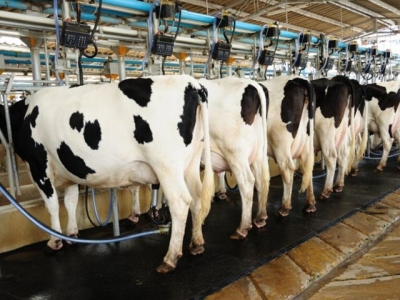Dairy calf diets: what is the impact of nutrition on gene expression

Dairy calf diets: what is the impact of nutrition on gene expression, what type of fatty acids should be used?
Feeding a starter feed high in fat may help to attenuate the slump in growth at weaning in calves raised on intensive feeding programs, says an IRTA researcher.
Alex Bach, ICREA research professor at the Barcelona based Institut de Recerca i Tenologia Agroalimentàries (IRTA), carries out research to understand the physiology and metabolism of ruminants, with special emphasis on the impact of nutrition and management during early development on future metabolic function.
We last spoke to him at the Phileo Lesaffre ruminant symposium in Toulouse in June 2016, where he explained that to achieve greater calf growth in early life, the optimum amount of milk replacer or milk needed daily is six liters, fed at three different times. This was the best approach for calf rumen development, solid feed intake and digestion efficiency, said Bach.
Fatty acid content
“In calves, we are continuing to play with that, to consolidate the data, so as to stimulate solid feed consumption in calves. But we are also looking at what should be the optimum fatty acid levels in milk replacers [and starter feeds] for dairy calves,” he told us today.
In a study involving Bach, published in 2014, the researchers looked at the interaction between milk allowance and fat content of the starter feed on performance of Holstein calves.
They concluded that though “feeding a high-fat starter feed depressed intake after weaning, increasing the fat content of the starter feed to 11.2% when offering 6 L/d of milk replacer increased overall BW and tended to increase growth.”
Bach said he is also assessing the benefits, or otherwise, of short chain over long chain fatty acids.
A 2009 Polish study aimed at determining the effect of the short chain fatty acid, sodium butyrate (NaB), as a supplement in milk replacer and starter diet on rumen development in rearing calves, found it might enhance their rumen development.
In addition, Bach and his colleagues are focused on evaluating, through the use of biomarkers, the impact nutrition, or protein and energy levels to be precise, has on gene expression in dairy calves: "Producers are investing in genetics, nutritionists must ensure that those genes are actually expressed and this depends, partly, on the way calves are fed early in life."
Maternal diets
Writing in Progressive Dairyman, Bach noted that, in dairy cattle, there is little data about the potential effects of maternal metabolic status on subsequent metabolic function of her calves.
Little is known, he stressed, about the nutrient requirements linked to early pregnancy.
Bach also said the dam’s energy balance during gestation seems to affect the offspring
“Although macronutrient requirements for embryonic growth are low in early pregnancy, it is likely the embryo is sensitive to micronutrient deficiencies, circulating concentrations of hormones and growth factors… Perturbations in the methionine-homocysteine and folate cycles associated with inadequate methyl donors (i.e., methionine, folic acid, vitamin B12, homocysteine) supply during development stages, may lead to hypomethylation of DNA and deregulation of the offspring’s gene expression and metabolism.”
In relation to that he told us a low energy diet, providing about 15 Mcal of NEl/d before calving, is recommended.
Moreover, a protein deficiency in the dam during early pregnancy may compromise the reproductive performance of the offspring, said the ruminant nutrition expert.
Bach said he and his team are also reviewing the best nutritional and stress management strategies the industry might adopt to support dairy cows during the dry period. He said producers should avoid reducing the supply of key nutrients around dry-off to minimize stress and intrammary infections and ensure good milk yield in the following lactation.
Related news
 Can garlic oil reduce calf greenhouse gas emissions?
Can garlic oil reduce calf greenhouse gas emissions? Garlic oil may offer a way to reduce cow gas emissions when used with a high concentrate diet, say researchers.
 Limited diets with high DDGs inclusion support growth, nutrient digestion in dairy heifers
Limited diets with high DDGs inclusion support growth, nutrient digestion in dairy heifers Use of high levels of dried distillers grains maintains growth performance and increases digestibility for dairy heifers getting limited rations,says researcher
 Feeding cows milk that may contain antibiotic residues - what's the risk?
Feeding cows milk that may contain antibiotic residues - what's the risk? EFSA says the feeding to calves of colostrum and milk containing residues of antimicrobials that could select for antimicrobial-resistant bacteria